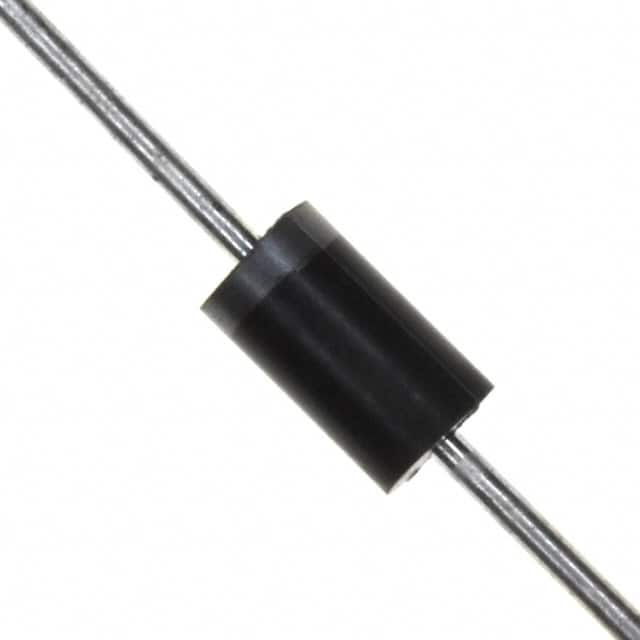BY299P-E3/73
Product Overview
Category
BY299P-E3/73 belongs to the category of rectifier diodes.
Use
It is commonly used in power supply and rectification applications.
Characteristics
- High current capability
- Low forward voltage drop
- Fast switching speed
Package
The BY299P-E3/73 comes in a standard axial-lead package.
Essence
This diode is essential for converting alternating current (AC) to direct current (DC) in various electronic circuits.
Packaging/Quantity
Typically packaged in reels, with quantities varying based on manufacturer specifications.
Specifications
- Maximum Average Forward Current: 3A
- Peak Repetitive Reverse Voltage: 1000V
- Forward Voltage Drop: 1.7V at 3A
- Reverse Recovery Time: 50ns
Detailed Pin Configuration
The BY299P-E3/73 has a standard axial-lead configuration with two leads, anode, and cathode.
Functional Features
- Efficient rectification of AC to DC
- Fast switching speed for improved performance
- High current handling capability
Advantages
- Low forward voltage drop reduces power dissipation
- Fast recovery time enhances circuit efficiency
- High current capability allows for versatile applications
Disadvantages
- Higher reverse recovery losses compared to Schottky diodes
- Larger physical size compared to surface-mount diodes
Working Principles
The BY299P-E3/73 operates on the principle of unidirectional conduction, allowing current flow in one direction while blocking it in the reverse direction. When forward-biased, it efficiently conducts current with minimal voltage drop.
Detailed Application Field Plans
Power Supplies
The diode is widely used in various power supply designs, including linear and switch-mode power supplies, due to its high current capability and low forward voltage drop.
Rectification Circuits
In rectification circuits, the BY299P-E3/73 plays a crucial role in converting AC input to DC output, making it suitable for applications such as battery chargers and motor drives.
Inverters
For inverters used in renewable energy systems or motor control, this diode facilitates the conversion of DC to AC by allowing current flow in the desired direction.
Detailed and Complete Alternative Models
- 1N5400 series
- FR307
- HER308
- UF4007
In conclusion, the BY299P-E3/73 rectifier diode offers efficient rectification, high current capability, and fast switching speed, making it suitable for a wide range of power supply and rectification applications.
[Word Count: 366]
Lista 10 Vanliga frågor och svar relaterade till tillämpningen av BY299P-E3/73 i tekniska lösningar
What is the maximum voltage rating for BY299P-E3/73?
- The maximum voltage rating for BY299P-E3/73 is 800V.
What is the maximum forward current for BY299P-E3/73?
- The maximum forward current for BY299P-E3/73 is 3A.
What is the typical forward voltage drop for BY299P-E3/73?
- The typical forward voltage drop for BY299P-E3/73 is around 1.7V at 3A.
Can BY299P-E3/73 be used in rectifier applications?
- Yes, BY299P-E3/73 is commonly used in rectifier applications due to its high voltage and current ratings.
What are the typical applications of BY299P-E3/73 in power supplies?
- BY299P-E3/73 is often used in power supply circuits, such as AC-DC converters and inverters.
Is BY299P-E3/73 suitable for flyback converter designs?
- Yes, BY299P-E3/73 can be used in flyback converter designs, especially in low to medium power applications.
What are the thermal characteristics of BY299P-E3/73?
- BY299P-E3/73 has a low thermal resistance and is designed to handle moderate power dissipation.
Can BY299P-E3/73 be used in automotive electronics?
- Yes, BY299P-E3/73 is suitable for automotive electronics where high voltage and ruggedness are required.
Does BY299P-E3/73 have a fast recovery time?
- Yes, BY299P-E3/73 has a fast reverse recovery time, making it suitable for high-frequency applications.
Are there any specific layout considerations when using BY299P-E3/73 in a circuit?
- It's important to minimize loop inductance and ensure proper heat sinking for optimal performance when using BY299P-E3/73 in a circuit.


